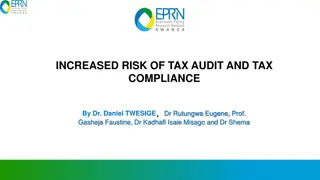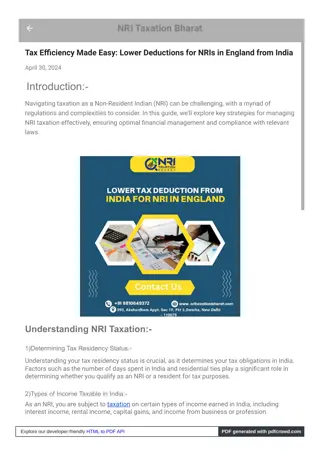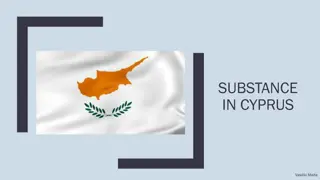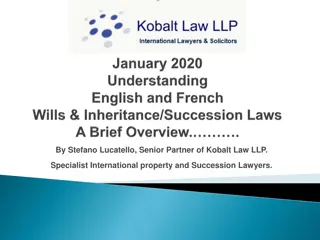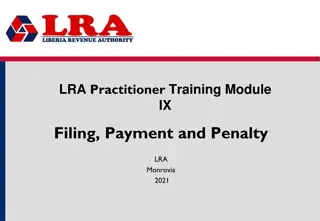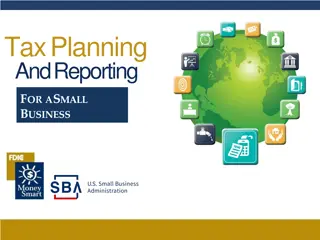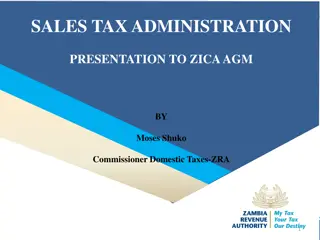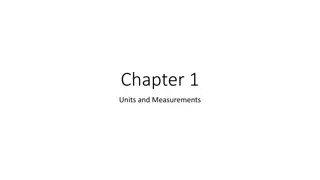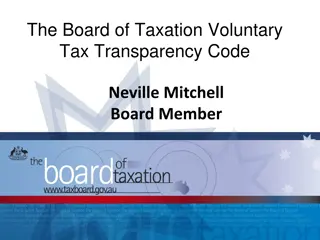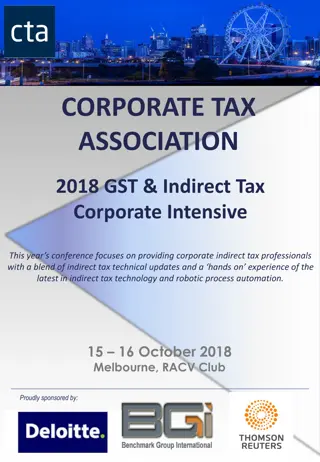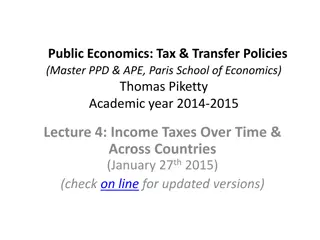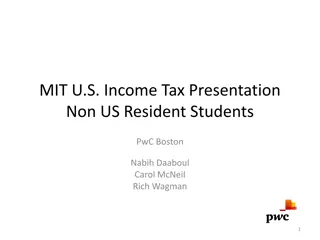- Assessment (Tax) Units & System Function
- This content focuses on understanding the Assessment (Tax) Units and the system function within the UKMOD project at the Institute for Social & Economic Research, University of Essex. It explains the working of UKMOD, the definition of assessment units, the avoidance of splitting up families, and how parameters are implemented using the system function DefTU. Discover how different types of assessment/tax units are defined and named, such as HH, IND, and SUBGROUP, with examples and detailed explanations provided. Gain insights into the Policy.DefTu and DepChildCond.DefTu in defining assessment units in the context of tax-benefit policy simulations using the EUROMOD software.
Download Presentation

Please find below an Image/Link to download the presentation.
The content on the website is provided AS IS for your information and personal use only. It may not be sold, licensed, or shared on other websites without obtaining consent from the author.If you encounter any issues during the download, it is possible that the publisher has removed the file from their server.
You are allowed to download the files provided on this website for personal or commercial use, subject to the condition that they are used lawfully. All files are the property of their respective owners.
The content on the website is provided AS IS for your information and personal use only. It may not be sold, licensed, or shared on other websites without obtaining consent from the author.
E N D
Presentation Transcript
UKMOD: Assessment (Tax) Units & system function DefTU UKMOD Project Institute for Social & Economic Research University of Essex
2 Reminder: How does UKMOD work? Original micro-data (FRS for the UK) Input micro-data (FRS or hypothetical households data) Model: Tax-benefit policy code (via the EUROMOD User Interface) Policy simulations (EUROMOD software) Output micro-data = input micro-data + additional simulated variables Tools for analysis: Statistics Presenter (or statistical software e.g. Stata)
3 In this lecture, you will learn about: What assessment (tax) units are and how they work o How the head and other members of the assessment unit is defined in UKMOD o How to avoid splitting up families o Footnote parameters how they are implemented in UKMOD, using the system function DefTU
4 Assessment/Tax Unit Unit: group of household members to be considered together Defined with System function DefTU usually in policy TUDef_xx Defined the first time used by the model o (although can be updated see UpdateTU in extra slides) Naming convention: tu_yyyy_xx Parameter Type in DefTU defines the composition of the tax unit HH: all individuals of the household are in the same unit. IND: each individual of the household forms its own unit. SUBGROUP: individuals determined by parameter Members form a unit. The household may be split into several units of different size. o o o
5 Type of assessment/tax unit Policy DefTu Name Type System Name on tu_individual_uk IND dag<16 | (dag<19 & IsInEducation & !IsMarried) on tu_household_uk HH dag<16 | (dag<19 & IsInEducation & !IsMarried) on tu_family_uk SUBGROUP Comment Made-up example: individual aged less than 16; or less than 19, in education and not married Made-up example: household DepChildCond DefTu Name Type aged less than 16; or less than 19, in education and not married Made-up example: nuclear family DepChildCond DefTu Name Type Members Partner & OwnDepChild dag<16 | (dag<19 & IsInEducation & !IsMarried) head, head's partner, own dependent children aged less than 16; or less than 19, in education and not married DepChildCond
6 Assessment/tax units: examples description idhh idperson idpartner idmother idfather dag Household Individual Family (i.e. Subgroup) A1 A1 A1 A1 A2 A2 A3 A3 A4 A5 B5 A6 A6 B6 A6 A6 C6 typical family 1 1 1 1 2 2 3 3 4 5 5 6 6 6 6 6 6 101 102 103 104 201 202 301 302 401 501 502 601 602 603 604 605 606 102 101 0 0 202 201 0 0 0 0 0 602 601 0 0 0 0 0 0 0 0 30 28 3 1 56 55 35 6 25 22 23 48 45 20 15 10 70 A1 A1 A1 A1 A2 A2 A3 A3 A4 A5 A5 A6 A6 A6 A6 A6 A6 A1 B1 C1 D1 A2 B2 A3 B3 A4 A5 B5 A6 B6 C6 D6 E6 F6 102 102 0 0 0 301 0 0 0 606 0 602 602 602 0 101 101 0 0 0 0 0 0 0 0 0 601 601 601 0 couple.without children lone parent single two singles living together large family
7 Head of the tax unit The head of a tax unit is by default o the richest member (System Configuration: Income for Head Definition) the oldest with the smallest personal id (i.e. idperson) Additional, optional specifications for the head: Query Value type Default Description Incomelist used for determining who is the richest person in the assessment unit, see parameter ExtHeadCond. HeadDefInc variable or incomelist ils_origy Condition further defining the head of the assessment unit. ExtHeadCond condition !IsDepChild If set to yes: an error is issued if ExtHeadCond rules out all household members. If set to no: no error issued, instead ExtHeadCond is dropped for affected households. StopIfNoHeadFound yes/no no If set to yes (possible) child status is removed if person is the Head of the assessment unit. If set to yes (possible) child status is removed if person is Partner as defined by parameter PartnerCond. NoChildIfHead yes/no no NoChildIfPartner yes/no no
8 Members of the tax unit (1) If tax unit type is SUBGROUP, parameter Members defines which hh members form a unit Relations are often defined with respect to the head of the unit o e.g. Partner, OwnChild, DepParent The status of each member is defined by a xCond parameter o e.g. PartnerCond, OwnChildCond, DepParentCond
Members of the tax unit (2) 9 Query Members Default n/a Description Specifies which members of the household form a unit, if parameter Type is set to SUBGROUP, e.g. Partner & OwnChild. Condition defining who is a partner, i.e. the partner of the head. PartnerCond head:idperson=idpartner DepChildCond 0, i.e. nobody is a child Condition defining who is a dependent child. The parameter equals 0, i.e. nobody is child, if not defined or set to n/a. However, setting the parameter to Default is the same as typing !IsParent & idpartner=0. OwnChildCond head:idperson=idmother | head:idperson=idfather | partner:idperson=idmother | partner:idperson=idfather Condition defining who is an own child: either the head or the head's partner is the mother/father of the child. OwnDepChildCond IsOwnChild & IsDepChild LooseDepChildCond idmother=0 & idfather=0 & IsDepChild DepParentCond head:idmother=idperson | head:idfather=idperson | partner:idmother=idperson | partner:idfather=idperson DepRelativeCond 0, i.e. nobody is a dependent relative Condition defining who is a dependent relative. Condition defining who is an own dependent child. Condition defining who is a loose dependent child. Condition defining who is a dependent parent, i.e. the parent of the head or the head's partner. LoneParentCond IsParentOfDepChild & idpartner=0 Condition defining who is a lone parent.
10 Examples: Members of the tax unit (1) head: subsequent variable refers to the head partner: subsequent variable refers to the partner of the head Default setting can be overwritten or combined with further specifications Policy DefTu Name Type Members System Name on tu_couple1_uk SUBGROUP Partner & DepParent head:idmother=idperson | head:idfather=idperson on tu_couple2_uk SUBGROUP Partner Comment Made-up example: couple with dependent parents head, head's partner and dependent parents overwriting the default condition: only include parents of the head Made-up example: couple DepParentCond DefTu Name Type Members head and head's partner PartnerCond Default & IsMarried default condition (i.e. head's partner) + partner is married
11 Examples: Members of the tax unit (2) DepChildCond: determines who is the dependent child OwnDepChild: a son or daughter (see OwnChildCond), who is a dependent child LooseDepChild: someone, who is a dependent child, but doesn t cohabit with parent/s Policy DefTu Name Type Members DepChildCond System Name on tu_family1_uk SUBGROUP Partner & OwnDepChild dag<=15 Comment Made-up example: nuclear family head, head's partner and own dependent children definition of the dependent child: aged 15 or less idhh idperson idpartner idmother idfather dag ils_origy IsHead IsPartner IsDepChild IsOwnDepChild IsLooseDepChild tax unit 1 101 102 0 0 44 2000 no 1 102 101 0 0 45 2100 yes 1 103 0 102 101 14 400 no 1 104 0 0 0 12 0 yes yes no no no no no yes yes no no yes no no no no yes A A A B
12 Examples: Members of the tax unit (3) DepChildCond: determines who is the dependent child OwnDepChild: a son or daughter (see OwnChildCond), who is a dependent child LooseDepChild: someone, who is a dependent child, but doesn t cohabit with parent/s Policy DefTu Name Type System Name on tu_family2_uk SUBGROUP Partner & OwnDepChild & LooseDepChild dag<=15 Comment Made-up example: nuclear family Members DepChildCond head, head's partner, own and loose dependent children definition of the dependent child: aged 15 or less idhh idperson idpartner idmother idfather dag ils_origy IsHead IsPartner IsDepChild IsOwnDepChild IsLooseDepChild tax unit 1 101 102 0 0 44 2000 no 1 102 101 0 0 45 2100 yes 1 103 0 102 101 14 400 no 1 104 0 0 0 12 0 no yes no no no no no yes yes no no yes no no no no yes A A A A
13 Avoiding splitting up families Value type Query Default Description If set to yes dependent children of dependent unit members (i.e. persons who are not Head or Partner of the head) are assigned to the unit. If set to yes partners of dependent unit members (i.e. persons who are not Head or Partner of the head) are assigned to the unit. AssignDepChOfDependents yes/no no AssignPartnerOfDependents yes/no no
14 Using conditions which refer to income If the assessment unit is bigger than the individual, monetary variables or income lists are assessed at the level of the whole unit Use footnote parameters to specify an alternative assessment unit Policy DefTu Name Type Grp/No System Name on tu_family_uk SUBGROUP Partner & OwnDepChild & LooseDepChild Comment Made-up example: family Members aged less than 25 and with (individual) earnings of less than GBP 1,000 per month earnings are assessed at the individual level DepChildCond dag<25 & yem#1 < 1000#m #_Level tu_individual_uk 1 Now let s have a look at footnote parameters
15 Parameters: Footnotes They serve the further specification of other parameters. Identified by #i (i=number from 1 to....) o Limits o Amounts o Assessment units o Specification of queries Policy Grp/No System Name Comment Made-up example: tax allowance for pensions the person's pensions - up to 1,000 per month - plus 30% of the sum of the couple's earned income and the pension of the partner upper limit on the person's pensions alternative assessment unit get the pension of the partner ArithOp on Formula #_UpLim #_Level #_Income output_var TAX_UNIT il_pensions#1 + (ils_earns#2 + GetPartnerIncome#3)*0.3 1000#m tu_couple_uk poa tintape_s tu_individual_uk 1 2 3
16 The tax unit in the output file tu_family_uk_IslLoneParent tu_family_uk_IsDePparent tu_family_uk_IsDepchild tu_family_uk_IsPartner Grp/ No tu_family_uk_Headed 101 101 103 104 201 201 201 201 5,201 5,201 5,201 5,201 5,201 5,201 9,202 9,202 9,203 9,202 Policy System Name DefTu on Name tu_family_uk Type SUBGROUP Partner & OwnDepChild & LooseDepChild & DepParent idpartner 102 101 idmother idperson 101 102 103 104 201 202 203 204 5,201 5,202 5,203 5,204 5,205 5,206 9,201 9,202 9,203 9,204 ils_origy idfather idhh yem dag 65 60 30 28 29 25 Members 1 1 1 1 2 2 2 2 0 0 0 0 0 0 0 0 0 0 0 1 0 0 0 1 0 0 0 1 0 0 0 0 0 0 0 0 0 0 0 0 0 0 1 1 0 0 1 1 0 0 0 0 0 1 0 0 0 0 0 0 0 0 0 0 0 0 1 1 1 0 0 0 0 0 0 0 0 0 0 0 0 0 0 0 0 0 0 1 0 0 DepChildCond dag<25 & yem#1<8000#y Default & dag>65 & yem#1<8000#y 0 0 102 102 101 101 DepParentCond 166 1,085 953 147 1,007 891 #_Level tu_individual_uk 1 202 201 0 0 0 0 AssignDepChOfDependents yes AssignPartnerChOfDependents yes 0 0 202 202 5,206 201 201 5,205 3 2 0 0 0 0 LoneParentCond Default & !IsMarried 52 52 52 52 52 52 92 92 92 92 5,202 5,201 40 38 10 15 70 70 80 38 34 11 1,954 1,831 0 0 0 0 0 0 0 0 0 0 0 0 0 0 0 0 5,202 5,202 5,201 5,201 5,206 5,205 0 0 0 0 0 0 0 0 0 0 0 0 0 9,201 9,201 9,202 3,740 2,483 3,502 2,324 0 0
17 Your Turn: Exercise 7 You will: o Create a new tax unit You can copy/paste an existing one (tu_bu_uk) and modify it o Use the function DefTU to create a new assessment unit where you change the age condition for being a dependent child Make a copy of UK 2019 system and call it e.g. UK_2019_e7 Reform the Child Benefit so that families with children aged 14+ no longer receive this benefit; o Run reform system and analyse impact on household incomes of the reform using the Statistics Presenter Detailed instructions and the full solution is available in word file o (Exercise 7_Reforming UK Child Benefit by narrowing its age condition.docx)
18 Summary: Exercise 7 You learned how to o Create a new assessment unit o Manipulate those assessment units that are already defined into the model
19 In this lecture, you learnt about: What assessment (tax) units are and how they work o How the head and other members of the assessment unit is defined in UKMOD o How to avoid splitting up families o Footnote parameters how they are implemented in UKMOD, using the system function DefTU
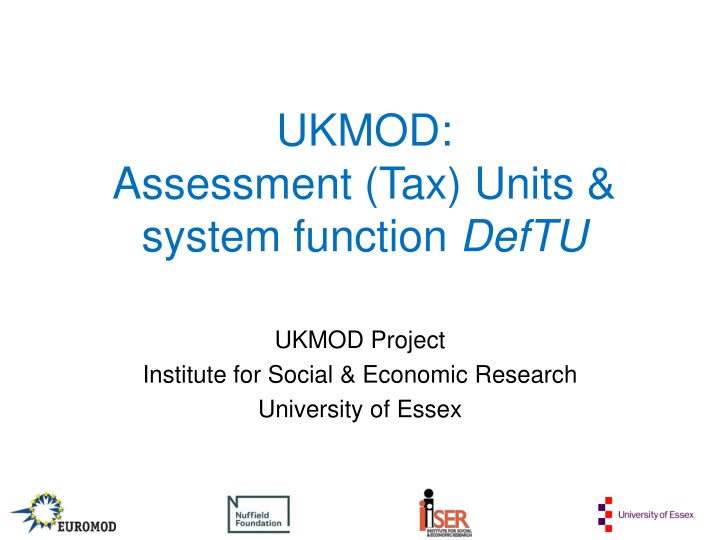



![Town of [Town Name] Real Estate Tax Rates and FY 2024 Budget Summary](/thumb/62211/town-of-town-name-real-estate-tax-rates-and-fy-2024-budget-summary.jpg)
